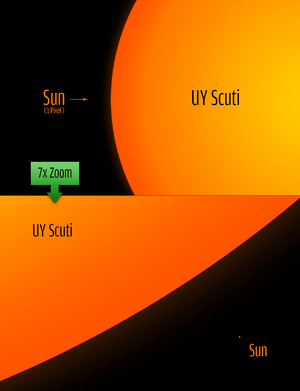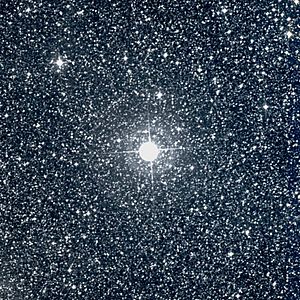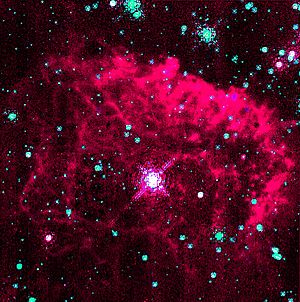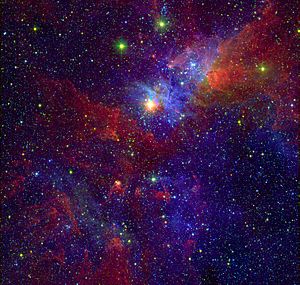Hypergiant facts for kids


A hypergiant (luminosity class 0) is a star with an enormous mass and luminosity, It shows signs of a very high rate of mass loss. The exact definition is not yet settled.
Hypergiants are the largest stars in the universe, usually larger than supergiants. The hypergiant with the largest known diameter is UY Scuti, which is about 1700 times wider than the Sun.
Another large hypergiant is NML Cygni, about 1,650 times wider than the Sun. It is one of the extreme luminous supergiant stars. The pulsating red supergiant UY Scuti is probably larger still.
Hypergiants are very hard to find and they have a short lifespan because of their size. While the Sun has a lifespan of around 10 billion years, hypergiants will only exist for a few million years.
Contents
Spectrum

There are two special groups: luminous blue variables (LBV), and yellow hypergiants. Both of these types are very rare, with only a few examples in the Milky Way galaxy. Their rareness is probably because each type passes through this stage quite rapidly.
Stability
As luminosity of stars increases greatly with mass, the luminosity of hypergiants often lies very close to the Eddington limit. This is the luminosity at which the force of the star's gravity equals the radiation pressure outward.
This means that the radiative flux passing through the photosphere of a hypergiant may be nearly strong enough to lift away the photosphere. Above the Eddington limit, the star would generate so much radiation that parts of its outer layers would be thrown off in massive outbursts. This would effectively restrict the star from shining at higher luminosities for longer periods.
A good candidate for hosting a continuum-driven wind is Eta Carinae, one of the most massive stars ever observed. Its mass is about 130 solar masses and its luminosity four million times that of the Sun. Eta Carinae may occasionally exceed the Eddington limit. The last time might have been outbursts observed in 1840–1860. These reached mass loss rates much higher than stellar winds would normally allow.
Another theory to explain the massive outbursts of Eta Carinae is the idea of a deeply situated hydrodynamic explosion, blasting off parts of the star’s outer layers. The idea is that the star, even at luminosities below the Eddington limit, would have insufficient heat convection in the inner layers, resulting in a density inversion potentially leading to a massive explosion. The theory has, however, not been explored very much, and it is uncertain whether this really can happen.
Images for kids
-
Very Large Telescope image of the surroundings of VY Canis Majoris
-
A hypergiant star and its proplyd proto-planetary disk compared to the size of the Solar System
-
Field surrounding the yellow hypergiant star HR 5171
See also
 In Spanish: Hipergigante para niños
In Spanish: Hipergigante para niños





